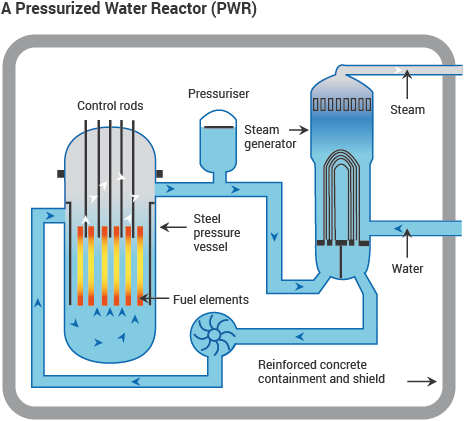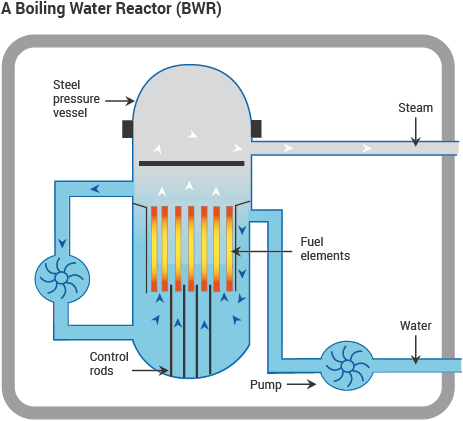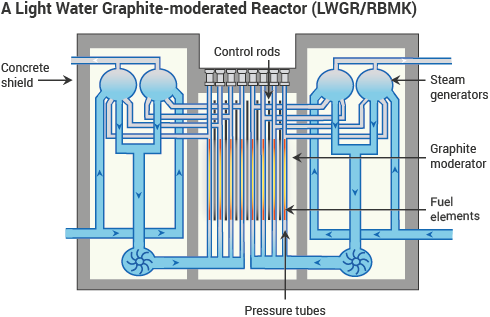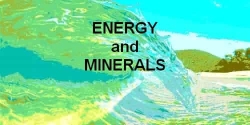Nuclear Reactors
Nuclear Reactors
Basic
Components of Most Types of Reactors
Pressurised water
reactor (PWR)
Boiling water reactor
(BWR)
Pressurised
heavy water reactor (PHWR)
Advanced
gas-cooled reactor (AGR)
Light
water graphite-moderated reactor (LWGR)
Fast neutron reactors
(FNR)
A nuclear reactor produces and controls the release of energy from splitting the atoms of certain elements.
In a nuclear power reactor, the energy released is used as heat to make steam to generate electricity.
Basic Components of Most Types of Reactors:
- Fuel
Uranium is the basic fuel. Usually pellets of uranium oxide (UO2) are arranged in tubes to form fuel rods. The rods are arranged into fuel assemblies in the reactor core.
In a 1000 MWe class PWR there might be 51,000 fuel rods with over 18 million pellets.
In a new reactor with new fuel a neutron source is needed to get the reaction going. Usually this is beryllium mixed with polonium, radium or other alpha-emitter. Alpha particles from the decay cause a release of neutrons from the beryllium as it turns to carbon-12. Restarting a reactor with some used fuel may not require this, as there may be enough neutrons to achieve criticality when control rods are removed. - Moderator Material
In the core which slows down the neutrons released from fission so that they cause more fission. It is usually water, but may be heavy water or graphite.
- Control rods
These are made with neutron-absorbing material such as cadmium, hafnium or boron, and are inserted or withdrawn from the core to control the rate of reaction, or to halt it. - Coolant
A fluid circulating through the core so as to transfer the heat from it. - Pressure vessel or pressure tubes
Usually a robust steel vessel containing the reactor core and moderator/coolant, but it may be a series of tubes holding the fuel and conveying the coolant through the surrounding moderator. - Steam generator
Part of the cooling system of pressurised water reactors (PWR & PHWR) where the high-pressure primary coolant bringing heat from the reactor is used to make steam for the turbine, in a secondary circuit. Essentially a heat exchanger like in a family hot water system*
- Containment
The structure around the reactor and associated steam generators which is designed to protect it from outside intrusion and to protect those outside from the effects of radiation in case of any serious malfunction inside. It is typically a metre-thick concrete and steel structure. Newer Russian and some other reactors install core melt localisation devices or 'core catchers' under the pressure vessel to catch any melted core material in the event of a major accident.
Pressurised water reactor (PWR)
This is the most common type, with about 300 operable reactors for power generation and several hundred more employed for naval propulsion. The design of PWRs originated as a submarine power plant. PWRs use ordinary water as both coolant and moderator.
The design is distinguished by having a primary cooling circuit which flows through the core of the reactor under very high pressure, and a secondary circuit in which steam is generated to drive the turbine. In Russia these are known as VVER types – water-moderated and -cooled.

Boiling water reactor (BWR)
This type of reactor has many similarities to the PWR, except that there is only a single circuit in which the water is at lower pressure (about 75 times atmospheric pressure) so that it boils in the core at about 285°C.
The reactor is designed to operate with 12-15% of the water in the top part of the core as steam, and hence with less moderating effect and thus efficiency there. The steam passes through drier plates (steam separators) above the core and then directly to the turbines, which are thus part of the reactor circuit.
Since the water around the core of a reactor is always contaminated with traces of radionuclides, it means that the turbine must be shielded and radiological protection provided during maintenance.

Pressurised heavy water reactor (PHWR)
The PHWR reactor has been developed in Canada as the CANDU.
PHWRs generally use natural uranium (0.7% U-235) oxide as fuel, hence needs a more efficient moderator, in this case heavy water (D2O).**
The PHWR produces more energy per kilogram of mined uranium than other designs.
The moderator is in a large tank called a calandria, penetrated by several hundred horizontal pressure tubes which form channels for the fuel, cooled by a flow of heavy water under high pressure (about 100 times atmospheric pressure) in the primary cooling circuit, typically reaching 290°C.
As in the PWR, the primary coolant generates steam in a secondary circuit to drive the turbines. The pressure tube design means that the reactor can be refuelled progressively without shutting down, by isolating individual pressure tubes from the cooling circuit.
CANDU reactors can accept a variety of fuels. They may be run on recycled uranium from reprocessing LWR used fuel, or a blend of this and depleted uranium left over from enrichment plants. About 4000 MWe of PWR might then fuel 1000 MWe of CANDU capacity, with addition of depleted uranium. Thorium may also be used in fuel.

Advanced gas-cooled reactor (AGR)
These are the second generation of British gas-cooled reactors, using graphite moderator and carbon dioxide as primary coolant. The fuel is uranium oxide pellets, enriched to 2.5 - 3.5%, in stainless steel tubes.
The carbon dioxide circulates through the core, reaching 650°C and then past steam generator tubes outside it, but still inside the concrete and steel pressure vessel (hence 'integral' design).
Control rods penetrate the moderator and a secondary shutdown system involves injecting nitrogen to the coolant. The high temperature gives it a high thermal efficiency – about 41%.

Light water graphite-moderated reactor (LWGR)
The main LWGR design is the RBMK, a Soviet design, developed from plutonium production reactors. It employs long (7 metre) vertical pressure tubes running through graphite moderator, and is cooled by water, which is allowed to boil in the core at 290°C and at about 6.9 MPa, much as in a BWR.
Fuel is low-enriched uranium oxide made up into fuel assemblies 3.5 metres long. With moderation largely due to the fixed graphite, excess boiling simply reduces the cooling and neutron absorbtion without inhibiting the fission reaction, and a positive feedback problem can arise, which is why they have never been built outside the Soviet Union.

Fast neutron reactors (FNR)
Some reactors do not have a moderator and utilise fast neutrons, generating power from plutonium while making more of it from the U-238 isotope in or around the fuel.
While they get more than 60 times as much energy from the original uranium compared with the normal reactors, they are expensive to build.
If they are configured to produce more fissile material (plutonium) than they consume they are called fast breeder reactors (FBR).


